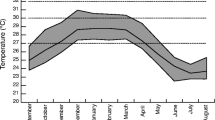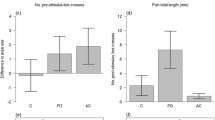Abstract
Animals use chemical cues to find food, locate mates, and detect potential predators. Detecting cues in a risky environment can induce behavioral changes to increase survival. Rusty crayfish (Orconectes rusticus) reduce activity, increase refuge use, and make defensive displays after detecting fish predator cues. However, no studies have introduced amphibian cues. We investigated crayfish responses to hellbender salamander (Cryptobranchus alleganiensis, a dominant predator of crayfish) cues and compared these to responses to largemouth bass (Micropterus salmoides) cues. Largemouth bass occur sympatrically with hellbenders and are known to induce distinct responses in rusty crayfish. We randomly assigned crayfish to predator cue and conspecific alarm cue combinations and recorded frozen behavior, appendage movement, locomotion, and refuge use. We found crayfish increased their proportion of time spent frozen and reduced their proportion of time spent active in the tank when exposed to either predator cue. Moreover, these responses were magnified when crayfish were exposed to predator cues in combination with conspecific alarm cues. Our experiment demonstrates evidence in support of the crayfish’s ability to detect and appropriately respond to predator cues alone and in combination with conspecific alarm cues. Future work should investigate the effects of these behavioral changes on trophic dynamics in a natural system.


Similar content being viewed by others
References
Acquistapace P, Daniels WH, Gherardi F (2004) Behavioral responses to “alarm odors” in potentially invasive crayfish species from aquaculture ponds. Behaviour 141:691–702
Bishop S (1994) Handbook of salamanders. Cornell University Press, New York
Blake MA, Hart PJB (1993) The behavioural responses of juvenile signal crayfish Pacifastacus leniusculus to stimuli from perch and eels. Freshw Biol 29:89–97. https://doi.org/10.1111/j.1365-2427.1995.tb01164.x
Bovbjerg RV (1953) Dominance order in the crayfish Orconectes virilis (Hagen). Physiol Zool 26:173–178
Breithaupt T (2001) Fan organs of crayfish enhance chemical information flow. Biol Bull 200:150–154. https://doi.org/10.2307/1543308
Breithaupt T (2011) Chemical communication in crustaceans. Springer, New York
Brown GE, Rive AC, Ferrari MCO, Chivers DP (2006) The dynamic nature of antipredator behavior: prey fish integrate threat-sensitive antipredator responses within background levels of predation risk. Behav Ecol Sociobiol 61:9–16. https://doi.org/10.1007/s00265-006-0232-y
Bruski CA, Dunham DW (1987) The importance of vision in agonistic communication of the crayfish Orconectes rusticus. Behaviour 103:83–107. https://doi.org/10.1017/CBO9781107415324.004
Bryer PJ, Mirza RS, Chivers DP (2001) Chemosensory assessment of predation risk by slimy sculpins (Cottus cognatus): responses to alarm, disturbance, and predator cues. J Chem Ecol 27:533–546
Burgmeier NG, Unger SD, Sutton TM, Williams RN (2011) Population status of the eastern Hellbender (Cryptobranchus alleganiensis alleganiensis) in Indiana. J Herpetol 45:195–201. https://doi.org/10.1670/10-094.1
Carnahan DP (2001) Blue river fisheries survey and game fish population estimates in Crawford, Harrison, and Washington counties. Fish management report 2000. Fisheries Section, Division of Fish and Wildlife, Indiana Department of Natural Resources, Indianapolis
Chivers DP, Smith RJF (1998) Chemical alarm signalling in aquatic predator-prey systems: a review and prospectus. Ecoscience 5:338–352
Clark JM, Kershner MW, Montemarano JJ (2013) Habitat-specific effects of particle size, current velocity, water depth, and predation risk on size-dependent crayfish distribution. Hydrobiologia 726:103–114. https://doi.org/10.1007/s10750-013-1548-z
Creed RPJ (1994) Direct and indirect effects of crayfish grazing in a stream community. Ecology 75:2091–2103
Epp KJ, Gabor CR (2008) Innate and learned predator recognition mediated by chemical signals in Eurycea nana. Ethology 114:607–615. https://doi.org/10.1111/j.1439-0310.2008.01494.x
Ferrari MCO, Wisenden BD, Chivers DP (2010) Chemical ecology of predator–prey interactions in aquatic ecosystems: a review and prospectus. Can J Zool 88:698–724. https://doi.org/10.1139/Z10-029
Garvey JE, Stein RA, Thomas HM (1994) Assessing how fish predation and interspecific prey competition influence a crayfish assemblage. Ecology 75:532–547
Gherardi F, Mavuti KM, Pacini N (2011) The smell of danger: chemical recognition of fish predators by the invasive crayfish Procambarus clarkii. Freshw Biol 56:1567–1578. https://doi.org/10.1111/j.1365-2427.2011.02595.x
Grabowski JH, Kimbro DL (2005) Predator-avoidance behavior extends trophic cascade to refuge habitats. Ecology 86:1312–1319
Hamrin SF (1987) Seasonal crayfish activity as influenced by fluctuating water levels and presence of a fish predator. Holarct Ecol 10:45–51
Hazlett BA (1985) Distrubance pheromones in the crayfish Orconectes virilis. J Chem Ecol 11:1695–1711
Hazlett BA (1994) Alarm responses in the crayfish Orconectes virilis and Orconectes propinquus. J Chem Ecol 20:1525–1535
Hazlett BA, Schoolmaster DR (1998) Responses of Cambarid crayfish to predator odor. J Chem Ecol 24:1757–1770
Hobbs HH Jr (1974) A checklist of the North and Middle American crayfishes (Decapoda: Astacidae and Cambaridae). Smith Cont Zool 166:1–161
Hoverman JT, Auld JR, Relyea RA (2005) Putting prey back together again: integrating predator-induced behavior, morphology, and life history. Oecologia 144:481–491. https://doi.org/10.1007/s00442-005-0082-8
Kamio M, Derby CD (2017) Finding food: how marine invertebrates use chemical cues to track and select food. Nat Prod Rep 34:463–560
Larsson P, Dodson S (1993) Invited review: chemical communication in planktonic animals. Arch Hydrobiol 129:129–155
Lima SL, Dill LM (1990) Behavioral decisions made under the risk of predation: a review and prospectus. Can J Zool 68:619–640. https://doi.org/10.1139/z90-092
Nyberg DW (1971) Prey capture in the largemouth bass. Am Midl Nat 86:128–144
Page LM, Burr BM (2011) Field guide to freshwater fishes of North America north of Mexico. Houghton Mifflin Harcourt, Boston
Paine RT (1980) Food webs: linkage, interaction strength, and community infrastructure. J Anim Ecol 49:667–685
Peacor SD, Werner EE (2001) The contribution of trait-mediated indirect effects to the net effects of a predator. Proc Natl Acad Sci USA 98:3904–3908. https://doi.org/10.1073/pnas.071061998
Peckarsky BL, Taylor BW, McIntosh AR (2001) Variation in mayfly size at metamorphosis as a developmental response to risk of predation. Ecology 82:740–757
Petranka JW (1998) Salamanders of the United States and Canada. Smithsonian Institution Press, Halethorpe
Petranka JW, Kats LB, Sih A (1987) Predator–prey interactions among fish and larval amphibians: use of chemical cues to detect predatory fish. Anim Behav 35:420–425. https://doi.org/10.1016/S0003-3472(87)80266-X
Pijanowska J (1997) Alarm signals in Daphnia? Oecologia 112:12–16. https://doi.org/10.1007/s004420050277
Schoeppner NM, Relyea RA (2005) Damage, digestion, and defence: the roles of alarm cues and kairomones for inducing prey defences. Ecol Lett 8:505–512. https://doi.org/10.1111/j.1461-0248.2005.00744.x
Schoeppner NM, Relyea RA (2009) Interpreting the smells of predation: how alarm cues and kairomones induce different prey defences. Funct Ecol 23:1114–1121. https://doi.org/10.1111/j.1365-2435.2009.01578.x
Shave CR, Townsend CR, Crowl TA (1994) The anti-predator behaviours of a New Zealand freshwater crayfish (Paranephrops zealandicus) to the native and an introduced predator. N Z J Ecol 18:1–10
Sih A, Petranka JW, Kats LB (1988) The dynamics of prey refuge use: a model and tests with sunfish and salamander larvae. Am Nat 132:463–483. https://doi.org/10.1086/660279
Smith RJF (1992) Alarm signals in fishes. Rev Fish Biol Fish 2:33–63
Stauffer HP, Semlitsch RD (1993) Effects of visual chemical and tactile cues of fish on the behavioural responses of tadpoles. Anim Behav 46:355–364. https://doi.org/10.1006/anbe.1993.1197
Stein RA, Magnuson JJ (1976) Behavioral response of crayfish to a fish predator. Ecology 57:751–761
Weissburg MJ (2000) The fluid dynamical context of chemosensory behavior. Biol Bull 198:188–202
Weissburg MJ (2011) Waterborne chemical communication: stimulus dispersal dynamics and orientation strategies in crustaceans. In: Breithaupt T, Thiel M (eds) Chemical communication in crusteans. Springer, Hull, pp 63–83
Weissburg M, Poulin RX, Kubanek J (2016) You are what you eat: a metabolomics approach to understanding prey responses to diet-dependent chemical cues released by predators. J Chem Ecol 42:1037–1046. https://doi.org/10.1007/s10886-016-0771-2
Werner EE (1986) Amphibian metamorphosis: growth rate, predation risk, and the optimal size at transformation. Am Nat 128:319–341. https://doi.org/10.1086/676645
Werner EE, Anholt BR (1993) Ecological consequences of the trade-off between growth and mortality rates mediated by foraging activity. Am Nat 142:242–272
Werner EE, Peacor SD (2003) A review of trait-mediated indirect interactions in ecological communities. Ecology 84:1083–1100
Wheeler BA, Prosen E, Mathis A, Wilkinson RF (2003) Population declines of a long-lived salamander: a 20+ year study of hellbenders, Cryptobranchus alleganiensis. Biol Conserv 109:151–156
Willman EJ, Hill AM, Lodge DM (1994) Response of three crayfish congeners (Orconectes spp.) to odors of fish carrion and live predatory fish. Am Midl Nat 132:44–51
Wilson DJ, Lefcort H (1993) The effect of predator diet on the alarm response of red-legged frog, Rana aurora, tadpoles. Anim Behav 46:1017–1019. https://doi.org/10.1006/anbe.1993.1285
Wyatt TD (2014) Pheromones and animal behavior: chemical signals and signatures, 2nd edn. Cambridge University Press, Cambridge
Acknowledgements
We thank Brian Tornabene and Veronica Yager for their hard work collecting crayfish for this experiment. All crayfish were collected under the IDNR scientific collection permit 15-111. We also thank Bob Rode for access to largemouth bass and the use of Purdue University’s Aquaculture Research Laboratory. We are grateful for the Williams laboratory group for their helpful comments and revisions to this manuscript.
Author information
Authors and Affiliations
Corresponding author
Ethics declarations
Funding
This project was funded through Purdue University’s College of Agriculture Undergraduate Research Grant, received by Paige Weldy.
Conflict of interest
The authors declare that they have no conflict of interest.
Informed consent
For this type of study formal consent is not required.
Ethical approval
This article does not contain any studies with human participants performed by any of the authors. All applicable international, national, and/or institutional guidelines for the care and use of animals were followed. All procedures performed in studies involving animals were in accordance with the ethical standards of the institution or practice at which the studies were conducted; PACUC #1406001094314.
About this article
Cite this article
Kenison, E.K., Weldy, P.Y. & Williams, R.N. There must be something in the water: assessing the behavioral responses of rusty crayfish (Orconectes rusticus) to fish and amphibian predator kairomones. J Ethol 36, 77–84 (2018). https://doi.org/10.1007/s10164-017-0529-5
Received:
Accepted:
Published:
Issue Date:
DOI: https://doi.org/10.1007/s10164-017-0529-5




